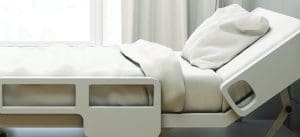Training, teamwork, and the right equipment can prevent pressure injuries.
Takeaways:
- Bariatric patients have a threefold risk of developing a pressure injury compared to those with a body mass index less than 40.
- Though challenging, turning and repositioning bariatric patients is crucial to reducing the risk of hospital-acquired pressure injuries.
- Effective solutions to the challenge of repositioning bariatric patients require education, teamwork, special equipment, and technology.
Acuity-adjusted staffing: A proven strategy to optimize patient care
The sliding patient: How to respond to and prevent migration in bed
PRESSURE INJURIES (PIs) are associated with increased length of hospital stay, high healthcare costs, and poor patient outcomes. Although many factors contribute to PI risk, morbid obesity (body mass index [BMI] > 40) is a significant and independent risk factor. Simple steps—such as turning and repositioning—that effectively reduce PI development in most patients are more challenging with patients who are obese.
Simple steps—such as turning and repositioning—that effectively reduce PI development in most patients are more challenging with patients who are obese.
Barriers to adopting new technology as well as a lack of resources, training, and special equipment to aid in turning and repositioning large patients can prevent nurses and other healthcare workers from providing the best possible care. However, a willingness to analyze the gaps in care and push for needed tools can help nurses keep these patient safe.
Understanding the pathophysiology
Patients who are morbidly obese are at risk for tissue injury, infections, and altered skin integrity because of abnormal adipose tissue distribution and skin physiology changes. As adipose tissue grows and multiplies, the density of the capillaries supplying the tissue doesn’t proportionally increase. Vascular insufficiencies that develop throughout the undernourished tissue can lead to tissue necrosis.
The increased size and weight of patients who are obese is strongly correlated to mobility limitations and predisposes them to remain sedentary for extended periods. These functional limitations contribute to prolonged compression of skin and underlying tissue with an already weakened vascular status. Without repositioning relief, significant skin and tissue damage results.
Patient care challenges
Adhering to turning and repositioning schedules is difficult in busy inpatient settings, but the weight and size of patients who are morbidly obese can make turning them even more difficult. In some cases, nurses have tried to do the best they can with limited resources and equipment. However, these “MacGyver” solutions can be harmful. (See A damaging “solution.”)
Reducing PI risk
Using ad hoc solutions and inappropriate equipment is unacceptable. Clinicians are charged with using best practices to deliver quality care. For PI prevention, this means adopting proven techniques (such as proper-size beds and turn wedges) and using new technologies (such as wearable sensors) that are proven to reduce PI incidence. (See Checklist: What you need to care for obese patients.) PIs are largely preventable if hospitals do three things:
• Train staff to take a team approach to caring for and repositioning patients who are obese.
• Make special equipment (bariatric beds, lifts, and wedges) designed to accommodate large patients readily available. Hospitals typically can rent bariatric beds when needed, but wedges need to be purchased.
• Deploy technology that clearly informs nurses when a patient turn is adequate for reperfusion and when the patient must be repositioned.
|
|
Training and teamwork
Nursing staff must be informed of the best practices and current evidence-based guidelines for PI prevention. Patient turning to prevent PIs has evolved through research and clinical practice into a tried-and-true standard of care and is a key recommendation in all major PI guidelines, including those from the National Pressure Ulcer Advisory Panel, the Institute for Healthcare Improvement, and the American College of Physicians. Repetition is the best way to keep these guidelines top of mind. Emphasize the information in safety huddles, with refresher training, and in staff meetings.
Mobilizing patients who are morbidly obese requires teamwork. Repositioning a large patient alone isn’t safe. Dedicated turn teams charged with regularly repositioning intensive care unit patients have shown a dramatic decrease in hospital-acquired pressure injury (HAPI) incidence. Hospitals that aren’t able to dedicate a turn team have found it helpful to have nurses and aides team up regularly throughout the shift to help each other turn patients. Appropriate equipment should be used for turning and lifting to avoid injury to both patients and staff. Brainstorming best practice strategies can help care teams get this important work done safely and effectively while fostering a culture of teamwork.
Equipped for success
Appropriate equipment, combined with adequate-size patient rooms and necessary personnel, is essential for safe and effective repositioning. A ceiling lift system with slings allows for safe patient handling and saves space. Bariatric beds provide enough space for safe and comfortable turning. Patients with a BMI > 35 who are unable to laterally reposition themselves should be placed on a wide bed. All patients whose BMI exceeds 45 should be placed on a wide bed, regardless of their mobility.
Specialty surfaces, such as low-air-loss beds or pressure-redistributing mattresses, can help reduce PI risk, but they don’t adequately offload tissues that have been exposed to pressure-induced ischemia; additional manual repositioning is necessary. Large patients need bariatric wedges in conjunction with a high-quality turn to ensure continued offloading for tissue reperfusion. Without the wedges, patients who have been turned are likely to return to their former position, reinjure ischemic tissue, and negate the time and effort the staff put into achieving the turn.
When choosing which wedges to use, note that not all bariatric wedges are created equal. Hospitals should stock bariatric wedges with increased height not length to facilitate a sufficient turn angle without putting more pressure on the sacrum. Sometimes, this may entail turning the wedge to the steeper angle to achieve the recommended 30-degree turn for tissue reperfusion.
Monitoring technology
A patient-monitoring system with wearable, wireless sensors has been shown to increase turning performance and significantly decrease HAPI occurrence in critical care patients. This technology helps clinicians track patient movement and alerts them when patients need assistance turning. It takes the guesswork out of turning by notifying staff when a turn is adequate for offloading and how long a patient must remain off tissue that’s been exposed to pressure.
Checklist: What you need to care for obese patientsEnsure that the hospital has a safe patient handling plan:
Ensure that the hospital has necessary space and equipment readily available:
Implement wireless patient monitoring technology to cue and remind staff when patients are due for repositioning. Monitoring systems optimize patient turning, reduce hospital-acquired pressure injuries, and help foster teamwork. |
No substitute for good communication
Regardless of what tools are available, clear and effective communication among staff and between staff and patients is critical to protecting patients who are morbidly obese from HAPIs.
Periodic meetings to reevaluate safe handling procedures specifically for large patients and timely staff updates help maintain an evidence-based HAPI prevention program. If few patients who are morbidly obese are admitted, staff might benefit from periodic refresher courses to practice and review safe patient handling skills.
Effective solutions
PIs are the most costly hospital-acquired conditions throughout the U.S. healthcare system, and the unreimbursed, incremental cost of treating just one average partial- to full-thickness PI can exceed $100,000. The consensus among experts is that most HAPIs are preventable. When considering the challenges of mobilizing patients who are morbidly obese, effective PI prevention solutions require taking a team approach and addressing equipment, resources, and training issues.
Melissa Klaeb and Bernadette Walters are both clinical consultants for Leaf Healthcare, Inc. Klaeb is based in Southern California, and Walters is based in Las Cruces, New Mexico.
Selected references
Beitz JM. Providing quality skin and wound care for the bariatric patient: An overview of clinical challenges. Ostomy Wound Manage. 2014;60(1):12-21.
Gardner LA, Pagano M. Skin integrity, immobility, and pressure ulcers in Class III obese patients. Pa Patient Saf Advis. 2013;10(4):156.
Hebert GR. Providing skin care for bariatric patients. Wound Care Advisor. 2015;4(6). woundcareadvisor.com/providing-skin-care-for-bariatric-patients-vol4-no6.
Hyun S, Li X, Vermillion B, et al. Body mass index and pressure ulcers: Improved predictability of pressure ulcers in intensive care patients. Am J Crit Care. 2014;23(6):494-500.
Pickham D, Berte N, Pihulic M, Valdez A, Mayer B, Desai M. Effect of a wearable patient sensor on care delivery for preventing pressure injuries in acutely ill adults: A pragmatic randomized clinical trial (LS-HAPI study). Int J Nurs Stud. 2018;80:12-9.
Pickham D, Pihulic M, Valdez A, Mayer B, Duhon P, Larson B. Pressure injury prevention practices in the intensive care unit: Real-world data captured by a wearable patient sensor. Wounds. 2018;30(8):229-34.
VHA Center for Engineering & Occupational Safety and Health. Bariatric Safe Patient Handling and Mobility Guidebook: A Resource Guide for Care of Persons of Size. July 2015. asphp.org/wp-content/uploads/2011/05/Baraiatrice-SPHM-guidebook-care-of-Person-of-Size.pdf
Wiggermann N, Smith K, Kumpar D. What bed size does a patient need? The relationship between body mass index and space required to turn in bed. Nurs Res. 2017;66(6):483-9.



















